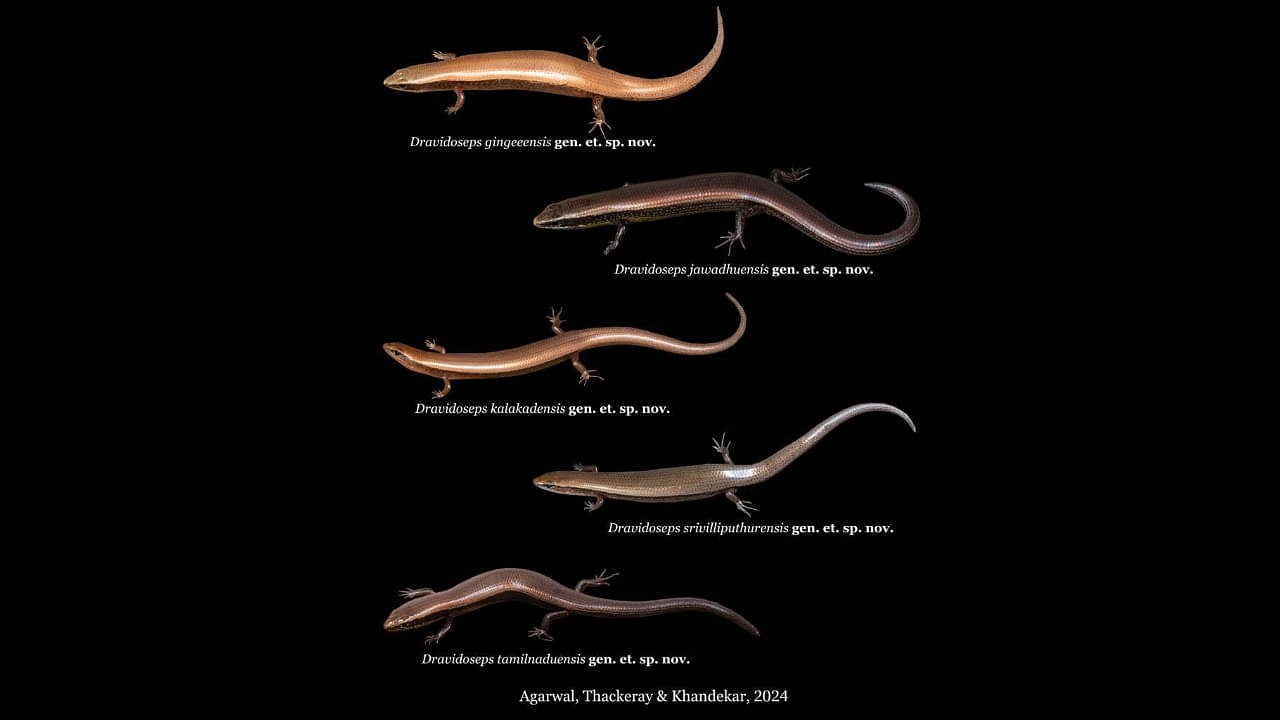DRAVIDOSEP

Disclaimer: Copyright infringement not intended.
Context
- A team of researchers has discovered the first-ever viviparous skink genus along with five new species in the peninsular region of India.
- These species include 'Dravidoseps gingeeensis,' 'Dravidoseps jawadhuensis,' 'Dravidoseps kalakadensis,' 'Dravidoseps srivilliputhurensis,' and 'Dravidoseps tamilnaduensis.'
Discovery
- Viviparous skinks, reptiles capable of giving birth to live young, were found inhabiting the forests of Tamil Nadu, Goa, and Maharashtra.
Dravidoseps
- The newly identified genus is named 'Dravidoseps,' derived from the Sanskrit words 'Dravid' and 'Seps.'
Distinct Characteristics of 'Dravidoseps':
- What sets 'Dravidoseps' apart is its viviparous nature, meaning it gives birth to live offspring instead of laying eggs.
- This distinctive feature marks a departure from the previously known genus, 'Subdoluseps.' The discovery also highlights other notable differences in characteristics.
Expanded Geographic Range and Significance:
- The species 'Dravidoseps gouensis,' belonging to the new genus, was found in North Goa and specific districts in Maharashtra.
- The discovery now positions 'Dravidoseps' as the most diverse endemic skink genus in the region, boasting seven species in Tamil Nadu and one each in Goa and southern Maharashtra.
Skinks
Introduction:
- Definition: Skinks refer to a family of lizards belonging to the family Scincidae, comprising more than 1,500 species.
- Distribution: They are found in various habitats globally, with a diverse range from deserts to forests.
Physical Characteristics:
- Limbs: Most skinks have reduced limbs or are entirely limbless, giving them a snake-like appearance.
- Scales: Their overlapping, shiny scales provide a protective covering.
- Tail Autotomy: Skinks can shed their tails as a defense mechanism, and the tails may regenerate.
Reproduction:
- Viviparity: Some skinks, like the recently discovered genus 'Dravidoseps,' exhibit viviparity, giving birth to live young rather than laying eggs.
- Oviparity: Others lay eggs, with some species featuring hard-shelled eggs.
Diet:
- Carnivorous: Skinks are primarily carnivores, feeding on insects, worms, small vertebrates, and plant matter.
- Foraging: They use their keen sense of smell and sight to locate prey.
Habitat:
- Diversity: Skinks inhabit a wide range of environments, including tropical rainforests, deserts, grasslands, and rocky areas.
- Burrowing: Some species are adept burrowers, creating tunnels in the ground.
Importance in Research:
- Scientific Significance: Skinks, being a diverse family, contribute significantly to reptilian biodiversity studies.
- Discoveries: Recent findings, such as the discovery of the viviparous skink genus 'Dravidoseps,' showcase ongoing research.
Threats and Conservation:
- Habitat Loss: Skinks, like many reptiles, face threats due to habitat destruction and climate change.
- Conservation Efforts: Conservation initiatives are crucial to preserving skink species and maintaining ecological balance.
Popular Skink Species:
- Blue-Tongued Skink: Recognizable by their blue tongues and relatively large size.
- Five-Lined Skink: Commonly found in North America, featuring distinctive stripes.
- Fire Skink: Known for its vibrant coloration, native to West Africa.
Human Interaction:
- Pet Trade: Some skink species are popular in the exotic pet trade, requiring specialized care.
- Role in Ecosystem: Skinks play a role in controlling insect populations, contributing to ecosystem balance.
|
PRACTICE QUESTION Q. Consider the following statements. 1.Skinks are exclusively herbivorous and known for their preference for forested habitats. 2.'Dravidoseps' is a genus characterized by viviparity and is found in the forests of Tamil Nadu, Goa, and Maharashtra. 3.Skinks are characterized by reduced limbs or complete limblessness, resembling a snake-like appearance. How many of the above statements are correct? a) Only 1 b) Only 2 c) Only 3 d) All Answer a) Only 1 Explanation
Therefore, out of the three statements, 1 is incorrect. The correct answer is a) Only 1 |





1.png)
